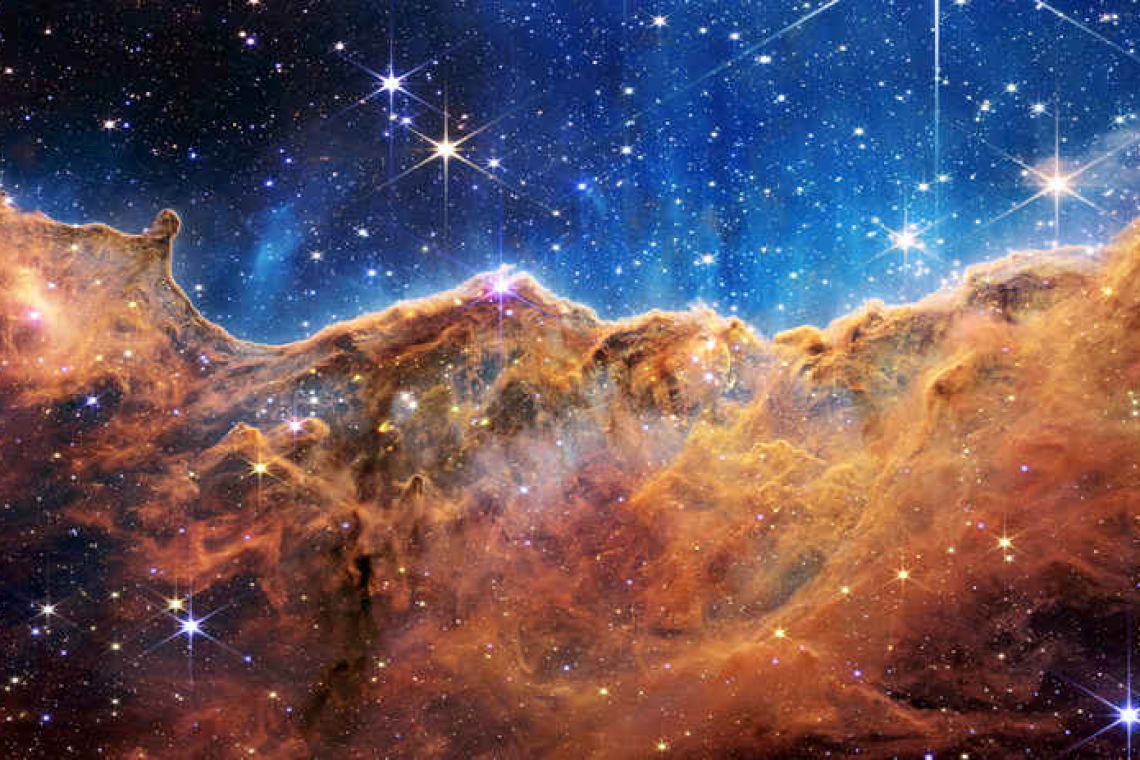The "Cosmic Cliffs" of the Carina Nebula are seen in an image divided horizontally by an undulating line between a cloudscape forming a nebula along the bottom portion and a comparatively clear upper portion, with data from NASA's James Webb Space Telescope, a revolutionary apparatus designed to peer through the cosmos to the dawn of the universe and released July 12, 2022. Speckled across both portions is a starfield, showing innumerable stars of many sizes. (NASA, ESA, CSA, STScI, Webb ERO Production Team/Handout via Reuters)
GREENBELT, Maryland--NASA on Tuesday drew back the curtain on billions of years of cosmic evolution with the inaugural batch of photos from the largest, most powerful observatory ever launched to space, saying the luminous imagery showed the telescope exceeds expectations.
The first full-colour, high-resolution pictures from the James Webb Space Telescope, designed to peer farther than before with greater clarity to the dawn of the universe, were hailed by NASA as milestone marking a new era of astronomical exploration.
Nearly two decades in the making and built under contract for NASA by aerospace giant Northrop Grumman Corp, the $9 billion infrared telescope was launched on Dec. 25, 2021. It reached its destination in solar orbit nearly 1 million miles from Earth a month later.
With Webb finely tuned after months spent remotely aligning its mirrors and calibrating its instruments, scientists will embark on a competitively selected agenda exploring the evolution of galaxies, life cycle of stars, atmospheres of distant exoplanets, and moons of our outer solar system. "All of us are just blown away," Amber Straughn, Webb deputy project scientist at NASA's Goddard Space Flight Center in Maryland, said among a panel of experts who briefed reporters following the big reveal.
Whoops and hollers from a sprightly "cheer team" welcomed some 300 scientists, telescope engineers, politicians and senior officials from NASA and its international partners into a packed and auditorium at Goddard for the official unveiling. "I didn't know I was coming to a pep rally," NASA Administrator James Nelson said from the stage, enthusing that Webb's "every image is a discovery."
The event was simulcast to watch parties of astronomy enthusiasts worldwide, from Bhopal, India, to Vancouver, British Columbia. The first photos, which took weeks to render from raw telescope data, were selected by NASA to show off Webb's capabilities and foreshadow science missions ahead.
The crowning debut image, previewed on Monday by U.S. President Biden but displayed with greater fanfare on Tuesday, was a "deep field" photo of a distant galaxy cluster, SMACS 0723, revealing the most detailed glimpse of the early universe recorded to date. At least one faint galaxy measured among the thousands in the image is nearly 95% as old as the Big Bang, the theoretical flashpoint that set the expansion of the known universe in motion some 13.8 billion years ago, NASA said.
Among the four other Webb subjects getting their closeups on Tuesday were two enormous clouds of gas and dust blasted into space by stellar explosions to form incubators for new stars - the Carina Nebula and the Southern Ring Nebula, each thousands of light years away from Earth. The collection also included fresh images of another galaxy cluster known as Stephan's Quintet, first discovered in 1877, which encompasses several galaxies NASA described as "locked in a cosmic dance of repeated close encounters."
Apart from the imagery, NASA presented Webb's first spectrographic analysis of a Jupiter-sized exoplanet more than 1,100 light years away - revealing the molecular signatures of filtered light passing through its atmosphere, including the presence of water vapor. Scientists have raised the possibility of eventually detecting water on the surface of smaller, rockier Earth-like exoplanets in the future.
Built to view its subjects chiefly in the infrared spectrum, Webb is about 100 times more sensitive than its 30-year-old predecessor, the Hubble Space Telescope, which operates mainly at optical and ultraviolet wavelengths. The much larger light-collecting surface of Webb's primary mirror - an array of 18 hexagonal segments of gold-coated beryllium metal - enables it to observe objects at greater distances, thus further back in time, than any other telescope. Its infrared optics allow Webb to detect a wider range of celestial objects and see through clouds of dust and gas that obscure light in the visible spectrum.







